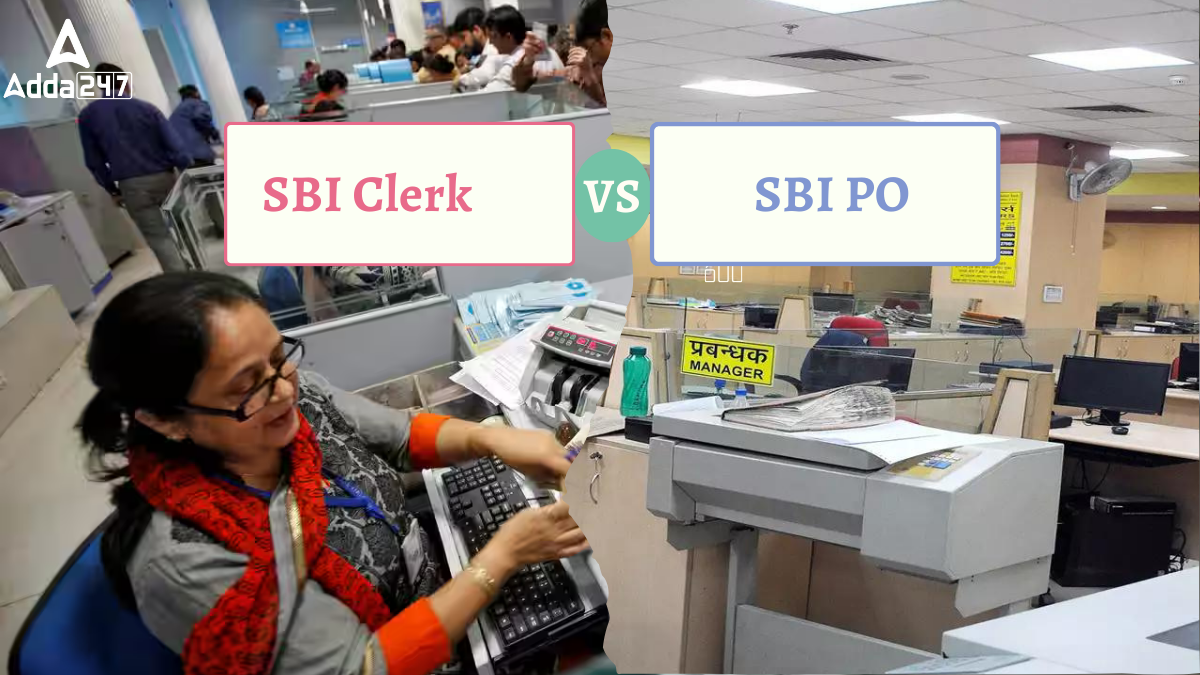Table of Contents
The State Bank of India (SBI) conducts recruitment drives for two of its most popular positions- SBI Clerk (Junior Associate) and SBI PO (Probationary Officer). Both roles offer lucrative career opportunities, but they differ in terms of job profile, responsibilities, salary and growth prospects. Many aspirants are often confused about which position suits them better. In this article, we will outline the major differences and similarities between the SBI Clerk and SBI PO positions to help you make an informed decision.
SBI Clerk vs SBI PO
Choosing between an SBI Clerk and an SBI PO position depends on your career aspirations, qualifications, and desired work environment. While the SBI Clerk role offers a stable job with a less stressful environment, the SBI PO role provides better career growth, higher salary and greater responsibilities. Both positions come with job security, excellent perks, and benefits.
| SBI Clerk vs. SBI PO: Major Differences | ||
| Parameter | SBI Clerk | SBI PO |
|---|---|---|
| Job Profile | Customer service, clerical tasks | Managerial role, supervision, decision-making |
| Selection Process | Prelims + Mains | Prelims + Mains + Interview/GD |
| Salary | ₹35,000 to ₹38,000 (in-hand) | ₹80,000 to ₹82,000 (in-hand) |
| Career Growth | Slow, limited managerial promotions | Fast track to managerial positions |
| Work Pressure | Low | High |
SBI Clerk vs. SBI PO Job Profile and Responsibilities
SBI PO (Probationary Officer) is a managerial position with responsibilities including team leadership, decision-making, and overseeing bank operations. In contrast, SBI Clerk is an entry-level position focused on day-to-day banking tasks such as customer service, account management, and transaction processing.
| SBI Clerk vs. SBI PO Job Profile and Responsibilities | ||
| Criteria | SBI Clerk | SBI PO |
|---|---|---|
| Primary Role | Frontline staff responsible for day-to-day customer service and routine banking operations. | Managerial role overseeing branch operations, staff management, and business targets. |
| Customer Interaction | High. Assists customers with tasks such as deposits, withdrawals, passbook updates, and cheque handling. | Moderate. Deals with high-value customers, loan approvals, account management, and escalated issues. |
| Core Responsibilities | – Cash handling – Account opening – Passbook updates – Fund transfers – Cheque verification – Clearing transactions |
– Loan processing and approval – Business development – Managing audits and compliance – Overseeing branch operations and ensuring staff efficiency |
| Decision-Making | Minimal. Operates under the guidance of officers or managers for complex issues. | High. Involves decision-making in areas like loan approvals, risk assessment, and strategic business development. |
| Operational Tasks | Performs clerical and administrative duties such as handling cash, maintaining ledgers, updating customer accounts, and record keeping. | Handles higher-level operations like managing staff, implementing policies, handling audits, and ensuring the branch meets performance goals. |
| Target Responsibilities | None. Primarily focuses on customer service and operational efficiency. | High. Has to meet sales and business targets related to loans, deposits, and insurance. |
| Supervisory Role | None. Works under the supervision of branch managers and officers. | Supervises and trains clerical staff, ensuring smooth operations in the branch. |
| Loan and Advances | Not involved in loan processing or sanctioning. | Directly responsible for processing and sanctioning loans, including risk evaluation and customer verification. |
| Transfers | Infrequent, usually within the region. | Frequent transfers, including rural or semi-urban postings, especially during the probation period. |
| Work Hours | Fixed working hours, typically 9 to 5. | Often exceeds regular working hours due to responsibilities like audits, meetings, and target deadlines. |
| Risk and Responsibility | Lower risk, as duties, are more operational and supervised. | High responsibility, involving risk in decision-making, loan approvals, and overall branch performance. |
SBI Clerk (Junior Associate)
- Customer Interaction: The primary role of an SBI Clerk is to assist customers in banking services like account management, cheque processing, cash deposits, and withdrawals.
- Back-office Work: SBI Clerks also handle clerical duties like maintaining records, data entry, and dealing with customer queries.
- Frontline Role: Clerks work at the front desk and are responsible for day-to-day banking transactions.
- Limited Decision-Making Power: Clerks generally follow guidelines set by higher authorities and have limited decision-making powers.
SBI PO (Probationary Officer)
- Management Role: An SBI PO undergoes extensive training and takes on managerial roles such as loan processing, overseeing branch activities, and handling customer disputes.
- Decision Making: POs are given more responsibilities, including sanctioning loans and other financial services.
- Supervisory Role: A PO supervises clerical staff and ensures smooth branch operations.
- Career Growth: After the probation period, POs are promoted to managerial roles, offering better career growth opportunities compared to clerks.
SBI Clerk vs SBI PO Selection Process
The selection process for SBI Clerk and SBI PO positions differs in complexity and stages. While both involve preliminary and main exams, the SBI PO selection additionally includes a group exercise and interview round, making it more rigorous compared to the SBI Clerk process.
| SBI Clerk vs. SBI PO: Selection Process | ||
| Phase | SBI Clerk | SBI PO |
|---|---|---|
| Phase I | Prelims | Prelims |
| Phase II | Mains | Mains |
| Phase III | LPT | Interview |
SBI Clerk Selection Process
- Prelims Exam: A qualifying exam with three sections—English, Numerical Ability, and Reasoning Ability.
- Mains Exam: A more comprehensive exam with sections including General/Financial Awareness, General English, Quantitative Aptitude, and Reasoning Ability.
- No Interview: The selection is made based on Mains performance, with no interview process involved.
SBI PO Selection Process:
- Prelims Exam: A qualifying exam similar to the Clerk’s but slightly tougher.
- Mains Exam: This exam includes sections on Data Analysis & Interpretation, General/Economy/Banking Awareness, English, and Reasoning.
- Interview & Group Discussion: After the Mains, shortlisted candidates undergo a Group Discussion (GD) and Personal Interview (PI) to assess their communication and leadership skills.
SBI Clerk vs SBI PO Salary Structure
The salary structure for SBI PO is generally higher than that of SBI Clerk, reflecting the difference in responsibilities and position hierarchy. SBI POs receive higher basic pay, more allowances and better perks, while SBI Clerks have a lower but stable pay scale with opportunities for increments and promotions over time.
SBI Clerk Salary
- The starting in-hand salary of an SBI Clerk ranges between ₹35,000 to ₹38,000, depending on the location.
- Annual Increment: The salary grows with time and performance-based increments.
SBI PO Salary:
- The initial in-hand salary of an SBI PO is around ₹80,000 to ₹82,000, including all allowances.
- Promotions & Increments: The pay scale for an SBI PO grows rapidly with time, offering numerous opportunities for promotions to managerial and executive positions.
SBI Clerk vs SBI PO Career Growth and Promotions
SBI POs typically enjoy faster career progression and more diverse growth opportunities within the bank’s hierarchy. SBI Clerks, while starting at a lower position, have a structured promotion path that can lead to officer-level roles over time, albeit at a slower pace compared to POs.
| SBI Clerk vs SBI PO Career Growth and Promotions | ||
| Position | SBI Clerk Promotion Path | SBI PO Promotion Path |
|---|---|---|
| Initial Position | Junior Associate (Clerk) | Probationary Officer (PO) |
| In-Cadre Promotion | In-cadre promotion based on performance and experience | Assistant Manager (JMGS-I) |
| Promotion to Officer Cadre | Promotion to Officer (Assistant Manager, JMGS-I) through internal exams | Deputy Manager (MMGS-II) |
| Mid-Level Promotions | Promotions depend on eligibility and passing internal exams | Manager (MMGS-III) |
| Senior Managerial Roles | Transition to Officer ranks possible but slower compared to PO | Senior Manager (Scale IV) |
| Executive Roles | Limited opportunities to move into senior positions in the officer cadre | Chief Manager |
| Top Executive Roles | Possible, but rare | Assistant General Manager (AGM) |
| Higher Management | Usually capped before AGM/DGM | Deputy General Manager (DGM) |
| Leadership Roles | Not typically available to clerks | General Manager (GM) |
| Top Executive/ Leadership | Not available | Chief General Manager, Deputy Managing Director |
| Executive Director | Not available | Managing Director |
| Chairman | Not available | Chairman |
SBI Clerk:
- Promotions for SBI Clerks are slower compared to POs, but they can advance to the position of Assistant Manager or JMGS-I after passing internal exams and interviews.
- SBI Clerks generally take several years to rise to managerial positions.
SBI PO:
- POs are on a fast track to promotions and can rise to higher management positions like Branch Manager, Assistant General Manager, and eventually Chief General Manager.
- The promotion process is accelerated, with SBI POs usually rising to managerial roles within a few years.
SBI Clerk vs SBI PO Work Pressure and Environment
SBI POs generally face higher work pressure due to managerial responsibilities and decision-making roles. SBI Clerks, while dealing with daily operational tasks and customer interactions, typically experience more routine work with relatively lower stress levels compared to POs.
| SBI Clerk vs SBI PO Work Pressure and Environment | ||
| Criteria | SBI Clerk | SBI PO |
|---|---|---|
| Job Role | Primarily customer-facing tasks, such as cash handling, and general banking services. | Managerial responsibilities include team leadership, decision-making, and operational management. |
| Work Pressure | Moderate. More routine tasks, with pressure during peak hours (e.g., month-end, year-end). | High. Responsible for meeting targets, managing staff, and handling complex situations. |
| Decision-Making | Limited to operational tasks; decisions require supervisory approval. | Involves significant decision-making in loans, advances, and risk management. |
| Deadlines & Targets | Lesser focus on deadlines; fewer sales and target-based tasks. | Regular targets for loan disbursements, sales, and branch performance. |
| Supervision | Works under supervision from officers or branch managers. | Supervises clerks and other staff, ensuring smooth branch operations. |
| Transfers | Less frequent; transfers are typically within the same region. | Frequent transfers across regions, especially in rural or semi-urban areas. |
| Work-Life Balance | Better work-life balance due to fewer responsibilities and regular working hours. | Challenging, as work often extends beyond office hours, especially during audits or target periods. |
| Career Growth Pressure | Comparatively lower as career progression is slower and based on internal exams. | High pressure for promotions and fulfilling expectations to climb the career ladder quickly. |
| Customer Interaction | High. Daily interaction with customers for services like passbook updates, deposits, withdrawals, etc. | Moderate. Customer interaction in terms of account management, loans, and handling escalations. |
SBI Clerk Work Pressure and Environment
- Clerks have a relatively less stressful work environment as they handle routine customer service tasks.
- The work timings are fixed, and there is usually less after-hours work.
SBI PO Work Pressure and Environment
- POs experience higher work pressure as they are responsible for managerial decisions, meeting targets, and handling customer disputes.
- The role often requires longer working hours and the flexibility to work under high-pressure situations.
SBI Clerk & PO Key Similarities
- Job Security: Both positions offer excellent job security as they are government jobs.
- Perks and Benefits: Both roles come with a wide range of benefits such as provident fund, medical insurance, housing benefits, and leave travel concession.
- Work-Life Balance: Although the roles differ in terms of responsibilities, SBI provides a good work-life balance in both positions, with holidays and leave policies.
| Related Post | |
| SBI Clerk 2024 | SBI PO 2024 |
| SBI Clerk Syllabus 2024 | SBI PO Syllabus 2024 |
| SBI Clerk Previous Year Papers | SBI PO Previous Year Papers |




 GA Capsule for SBI Clerk Mains 2025, Dow...
GA Capsule for SBI Clerk Mains 2025, Dow...
 The Hindu Review October 2022: Download ...
The Hindu Review October 2022: Download ...
 Rajasthan Gramin Bank Formed after Merge...
Rajasthan Gramin Bank Formed after Merge...


